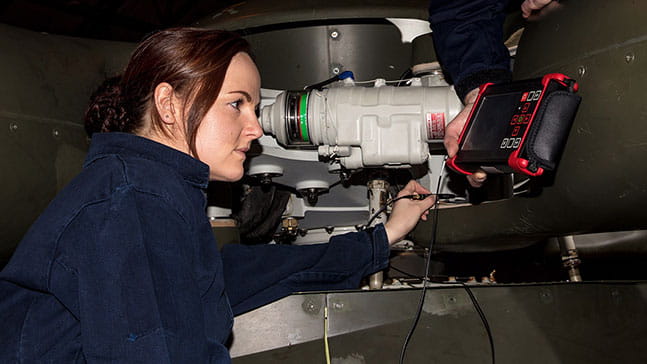Air Engineering Technician
You’ll take charge of scheduled maintenance, servicing and inspections for the Fleet Air Arm’s aircraft.
- £18,500 - £58,000
- No qualifications
- Fleet Air Arm
- Engineering
- Rating level
£25,200
Zero
£58,000
Free
6 weeks
Travel

I’ve always loved to tinker with things and have had an interest in mechanical engineering for years, it’s great to be part of a professional team that keep the squadron flying
Role details
What you’ll do
When you join the Royal Navy as an Air Engineering Technician, you’re vital to keeping our airborne missions on track. That means working with some of the most advanced aircraft on the planet, like the F35B Lightning Stealth Fighter, the Merlin Mk2 Submarine Hunter, the Merlin Mk4 Commando Helicopter or the Wildcat Maritime Attack Helicopter. You’ll carry out maintenance, as well as services and inspections, before and after each flight. The Fleet Air Arm increases our reach as an armed force, and you will have the opportunity to serve on the world’s most advanced ships and aircraft carriers deploying all around the world.
Your role
- Be a central part of the Royal Navy’s aviation capabilities, getting hands-on with our planes and helicopters, and making sure that they can take off whenever they’re needed.
- Develop your engineering skills and specialise in mechanical technology and avionics. You’ll need to use all of the knowledge you gain in training, to find innovative solutions to complex problems, often under pressure.
- You will have the opportunity to serve on the world’s most advanced Frigates, Destroyers and Aircraft Carriers with new and exciting aircraft Forces. This includes the F35B Lightning Stealth fighter at RAF Marham, the Merlin Mk2 Submarine Hunter, at RNAS Culdrose, the Merlin Mk4 Commando Helicopter and the Wildcat Maritime Attack Helicopter at RNAS Yeovilton.
- Maintain, service and inspect the Fleet Air Arm’s aircraft, working with your team at the highest levels of the engineering industry.
Pay & benefits
- A salary over £25,200 as soon as you finish training
- Potential earnings of £58,000 as your career progresses
- Six weeks of paid holiday every year
- Free medical and dental care
- Extra financial bonuses if you’re on a longer operation
- Earn additional Service Engineer Technical Pay as you progress to Leading Hand with increased pay levels on further promotion
- Amazing opportunities, including world travel and adventurous training for two weeks every year
- Free gym and sports, from football to kayaking to kite-surfing
- Forces Help to Buy scheme – a 0% loan to get you on, or further up, the housing ladder
- Subsidised travel, accommodation and food
Skills for life
Qualifications you'll gain
- Professional qualifications in aircraft engineering, including Level 2 Aviation Maintenance Mechanic
Opportunities open to you
- Study for GCSEs, then A-Levels in subjects including English, Maths and Science
- Gain specialist vocational qualifications – like Level 3 Apprenticeship Foundation Degree Modules depending on career progression
- The potential to gain a Foundation Degree in Aeronautical Engineering through the University of Portsmouth as you qualify for professional promotion
- Streamlined route to registration as EngTech and IEng with a professional body
Skills you'll develop
- As an Engineering Technician you will be embarking upon one of the country's top apprenticeship schemes
- We need your enthusiasm to maintain and report cutting-edge equipment on our most sophisticated helicopters and fighter jets, becoming familiar with a variety of sophisticated mechanical, avionics and weapon systems
- You will become a quick thinker and a problem solver who can integrate and become an essential part of the team
Eligibility
- You must be aged between 16 to 39
- No qualifications are required for this role
- You must be a United Kingdom citizen or British Dual National. Dual Nationality restrictions do apply
- You must have lived in the UK for 5 years continuously prior to application
- Minimum height of 145cm
- A Body Mass Index (BMI) between 18 and 28 (between 17 and 27 if under 18)
Skills & interests
- A quick thinker, with a passion for working with the latest equipment and technology
- A problem-solver who can work well as part of a team
- An affinity for aircraft and avionics
- Enthusiasm for fixing and maintaining electronic and mechanical systems
Joining process
From picking your role to starting on your first day, these are the steps you'll take to join as a rating.
Submit an application
Defence Aptitude Assessment (DAA)
You’ll be tested on: Verbal Reasoning, Numerical Reasoning, Work Rate, Spatial Reasoning, Electrical Comprehension and Mechanical Comprehension.
To prepare, you can practise the DAA
Interview
Candidate Preparation Course (CPC)
Start training
Career progression
Got a question?
Our virtual recruiter is available to answer your questions 24 hours a day
